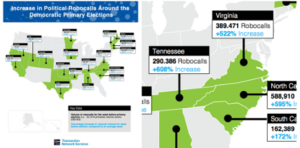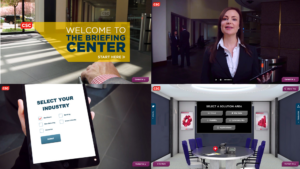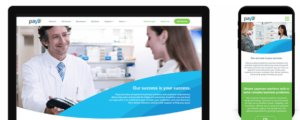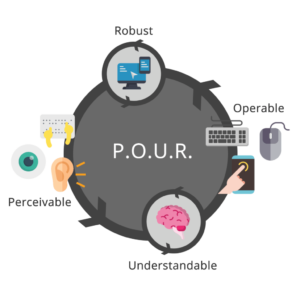The recent COVID-19 outbreak has had ripple effects across almost every industry. Around the world, the global pandemic has altered the way we live, socialize and even conduct business. In this unprecedented scenario clouded with uncertainty we all, especially digital marketers, are wondering: What needs to change? And how drastically?
When it comes to search engine optimization strategies, digital marketing and content agencies are continually researching the latest trends and evolving best practices. In the current environment, the role of a top digital marketing agency is to keep a pulse on the present, while also looking forward to strategies that will drive long-term success. Here at Bluetext, our digital marketing analysts are harnessing a variety of tactics to support overall business goals and serve users the best we can during these uncertain times. Check out the top ways we’ve been monitoring and optimizing around current events.
Strength in Numbers
When in doubt, trust the data! Using top marketing analytical tools, such as SEMRush and Moz, one can track the aggregate behavior of online users. Gathering the most up to date data can be tricky, so don’t do it alone. The more expertise and tools, the better. Trust a marketing analytics agency to help break down the numbers into a comprehensible story of website traffic. Use professional tools, such as Google Analytics and Google Search Console, to monitor the recent fluctuations in your page traffic. Do a keyword analysis of your current keyword list to see if search volume has shifted. Google Trends page is a great tool to identify emerging patterns. Are there new phrases your customers are searching for? If the language has evolved, so should your SEO strategy. If you have chatbots for customer service transcripts, these can provide valuable insight into current needs.
In short, the data doesn’t lie. Businesses need to understand search traffic shifts to get as clear as possible a picture into whether to pivot your SEO strategy or not.

Content is King — Still
Ultimately any changes to your SEO strategy should be driven by your unique business needs. For example, a brick and mortar store will need to cater to how they can serve customers at home. If your business was already available online, you may be experiencing altered user behavior as people spend more time at home and online. Every business should ask: “Is the content relevant to current needs?” Your messages may need to shift in sensitivity to the current environment. A complete overhaul is not necessary, nor appropriate. However, if there are opportunities to generate new content that supports your users in a unique time, do so. And if your business is considered essential or has been significantly impacted, you should create a dedicated page to capture all relevant coronavirus traffic. Keep the page simple, focused and sensitive. Don’t try to provide the latest breaking news, but exactly what and how your company is doing. If your business has been minimally affected, perhaps there is an opportunity to contribute to emerging conversations. Exploding Topics is a valuable tool for up-to-date trends across search engines and social media mentions. At the end of the day, users are seeking timely and accurate information now and long after the dust has settled on this pandemic.
 Optimize Often
Optimize Often
Search engine optimization is never a “one and done” task. Any digital marketing strategy requires upkeep as is the nature of the evolving industry. Now, more than ever, flexibility is paramount to staying afloat. Be proactive, be vigilant. SEO strategy will need re-evaluation in the upcoming weeks and months. No one can predict how long the pandemic will last so you must be ready to pivot to any new or resurging customer needs.
In an unpredictable environment, one thing is certain: this is our new (remote) reality. Don’t expect old strategies to work as they once did, and don’t expect this shift to “blow over soon”. Your business should be prepared to remain relevant now more than ever. There will likely be long term implications in behaviors and business operations. Get behind the shifts now and flex your agility. It will pay off in your long term business health.
If you’re looking to partner with an agency to pivot your SEO strategy, let us know.
As of late, communications have been drastically changing, and companies have had to adapt quickly and swiftly to accommodate the current COVID-19 environment. It is a new and unprecedented scenario, forcing flexibility and fast thinking to all aspects of the business. As work-from-home policies and entirely virtual communications surge, recruitment strategies have been greatly impacted. How a company reacts to this digital shift and adapts various business models is crucial to future success following the return to normalcy.
Improving Remote Recruiting & On-Boarding
Learning how to better recruit and virtually onboard, not only during COVID-19 but throughout a company’s entire lifespan, is essential. It demonstrates your company’s ability to stay flexible, proactive, and conform to different comfort levels.

Have a Convincing & Personalized Careers Page
Virtual recruiting isn’t a novel idea. Companies have been trying to actively attract new talent online for years. However, in order to get a great pool of new hires, you need one thing: an outstanding career section on your website. Your career section is the portal for all potential new employees to investigate your company, culture, benefits, growth opportunities, and what you are all about. This is your first impression to prospective employees, who are most likely browsing opportunities at multiple companies! The main mission of a career section is to make the biggest impact in the shortest amount of time. How do you do this? With the proper targeting.
Proper targeting isn’t all about spending large sums of money on paid media. It’s important to utilize your current resources and current employees to create a lasting campaign. Centauri, a technology-driven company providing high-end, creative software and engineering solutions to critical national security missions, came to Bluetext wanting a recruitment-focused campaign. Looking at the diversity in the age, specialty, race, gender and backgrounds of current employees, Bluetext created a range of different personas. Backtracking to Marketing 101, persona creation is a critical step in marketing to the right audience. It’s crucial to know a user’s specific goals, interests, and motivations. For example, a young college graduate student will have different goals versus an experienced middle-aged military veteran. By creating personas, potential employees are able to connect more with someone that closely resembles them. For proper targeting, personalization is key. The career section should play into all personas, create hyper-specific content and show the user relevant jobs pertaining to them. Sound like a lot of legwork? Digital marketing agencies, such as Bluetext, are experienced and proficient in persona creation and targeting strategies.

Leverage Alumni Networks
Another great way to better recruit qualified candidates is to create an Alumni Network. This can take many forms, with the most popular being an informal social media group harnessing Facebook or Linkedin). This creates a space for alumni to connect with others, share thoughts, and best of all, provide valuable leads. Not only are you getting free referral lead generation, you nurture an excellent relationship with the company even after the employee has left. It creates brand ambassadors who are constantly promoting your company in a positive light, possible future business partners, and topnotch re-hires.
Institute a Welcoming Virtual Onboarding Process
While virtual recruiting was surging in popularity even before COVID-19, virtual onboarding is relatively new. Companies like Amazon have already begun to virtually onboard thousands of new hires to keep up with higher demands. The biggest concern for most employers is exactly how to bring a newly-hired employee into the company and properly integrate them.
Onboarding is the first time a new employee gets a true first impression of the company in action. Maybe new hires came into the office to interview, but this is the real introduction to the nit and grit of day to day tasks. The first day typically involves numerous face-to-face meetings and handshakes–both no longer possible amidst the COVID pandemic. When virtually onboarding, It’s important to utilize scheduling software, internal communication platforms, and video conferencing tools in order to keep the initial introductory phase as personal, engaged, and genuine as possible. This is especially important for one-on-one meetings with direct managers.

Being able to leverage current new-hire learning processes virtually is a huge focus as well in the current environment. Do your new hires get a “Welcome Binder?” Replace that with a consolidated folder filled with the online version. Do you typically run through various Powerpoints with your new hires? Think about translating those into short, educational shared videos. Are there various informational sessions for new hires? Leverage video conferencing and screen sharing tools. Translating your in-person process to online can be done by almost anyone. In fact, the more people involved the better! Have multiple employees help create onboarding videos so that new hires get introduced to a wider breadth of the company.
The main goal of your virtual onboarding should be to make the new hire feel comfortable. Make sure to over-communicate and offer assistance as much as needed. Be sure they are understanding expectations laid out and asking questions when they feel confused. Make sure they get proper introductions, are included in virtual activities, and let them truly shine.
Virtual recruiting and onboarding are of utmost importance right now, but companies will benefit by taking advantage of these now and implementing these processes for all future recruiting and onboarding processes and the industry shifts. At Bluetext, there is no limit to the amount of success we can help you achieve. To learn more about our processes and to see our work, check out our case studies.
Ready to partner with Bluetext to achieve your marketing goals? Schedule a call with us today.
PR and marketing have changed overnight. There is still a need to reach customers and prospects, but it goes without saying that priorities have shifted in the “new normal” brought on by COVID-19.
It is a challenging tightrope to walk; the news cycle is rightly dominated by the coronavirus pandemic, which means many narratives that resonated pre-coronavirus will struggle to reach your target audiences. For our technology clients selling to government and enterprise decision makers – as well as consumers – we’ve preached several key PR and marketing tenets.
Chief among them is “do no harm.” If we have a client that can offer valuable expertise and insights to advance the conversation and help individuals and organizations navigate the current climate while protecting consumers and businesses, we support those efforts. But you can’t force connections that aren’t there and detract from those better positioned to make a positive impact. In other words, don’t be an opportunist. Don’t be an ambulance chaser. Those efforts will backfire and damage your brand.
Bluetext Digital Briefing Centers
Second, clients and their PR/marketing agencies need to be measured, but also creative and nimble. A government contractor or enterprise software company that relied on physical conferences and in-person sales meetings to engage with customers and prospects must now turn more attention to digital strategies.
Check out how Bluetext has developed Digital Briefing Centers (DBCs) for clients needing a dynamic way to digitally showcase to customers and prospects their full range of solutions in action. Customized presentations, live demos and in-depth discussions can be arranged while offering a proven short-term alternative and long-term complement to physical, face-to-face environments.

PR In the Age of Telework

Businesses can’t just throw up their hands and wait it out; there is still a need for smart PR and marketing to grow or at least sustain sales for the near-term. Digital Briefing Centers address the fact that your website and digital presence is by far now the most important doorway to your brand and brand experience while traditional, physical doors remain closed.
On the PR side, the best way to illustrate how Bluetext thinks when it comes to remaining proactive and creative with clients is through a real-life case study. Transaction Network Services (TNS) is a leading global data services provider with a telecom unit that provides robocall detection technology to U.S. telecom providers. Recognizing that scammers seize on the fear, chaos and confusion caused by health crises, we knew this was an opportunity for TNS to share its important data to help protect consumers from risks to their savings and personal information. Coronavirus scams cost people $7 million in the first 9 days of April alone — so the stakes are high.
Bluetext worked with TNS to rapidly build a strategy to communicate the financial risk to citizens and analyzing data to determine which robocall scams were most prevalent in which parts of the country. Some of the media coverage generated in a two-week period is included below.

In addition to developing a rapid response strategy, we started to think longer-term about robocall risks in the coming weeks and months. First, we worked with the client to gather data on political robocallers who were capitalizing on confusion regarding postponed Democratic Primary dates in a way that could influence election outcomes – and ensuring the data could be easily visualized.

The bottom line is this: we are in an uncharted phase as a society, and it is a phase that may last for months and even years. The organizations able to adapt to the “new normal” will be those best positioned to support their customers, partners and employees.
If you are looking for a partner to better position yourself to support your customers, reach out to Bluetext.
- The COVID-19 Pandemic has expanded the “stay at home” audience for B2C businesses.
- The consumer sector has seen changes in how audiences are reacting to content and consuming media.
- Capturing these audiences will require businesses to adapt content and tactics to the current climate.
Over the past few months, we have all adjusted to new living and working environments. This means varying working hours, virtual gatherings and different web surfing, streaming and social networking habits. These changes have shifted the traditional marketing audience profile.
If your business is B2C, you should be aware of these audience changes and adapt your marketing tactics to keep up with the current trends. Here are a few ways that you can make sure your message doesn’t fall flat with the new “stay at home” audience.

The concept of a “stay at home” audience is not new. The number of remote workers in the U.S. economy has grown steadily over the past several years. Online graduate and undergraduate programs have grown more popular, and the number of parents staying home with new children was rising even before the pandemic hit. Not to mention the number of companies adopting a digital-first approach and offering remote positions. However, this pandemic has rapidly expanded the “stay at home” audience beyond traditional groups.
It is crucial that all businesses hit the right tone with messaging during the pandemic. This is a different, uncertain and potentially difficult time for everyone, so brands should adjust their tone to one of encouragement and solidarity. No one wants to see pure sales messages at this time. Potential customers need to feel supported and confident that every purchase is essential for them.
Content
There are a few ways that businesses can cater to new stay at home audiences, one of which is content. One way to show solidarity with customers that may be struggling is by providing giveaways or special promotions that you normally wouldn’t – so that customers think of you again when more normal times return. Another way to build a loyal customer base could be to utilize user-generated content. Social proof is powerful, and often someone else’s high opinion of your product or service can make the difference between a static audience and gaining new customers.
It’s a myth that content management can be intensive or even a time burden. Updating your content could be as simple as shifting your product or service message slightly to be more specific to the audience’s changing needs. Some common threads throughout this pandemic are self-care, virtual everything (happy hours, games, workouts, entertainment), home cooking and other hobbies, home design, athleisure, online learning, DIY, gaming and financial services. Even if one of these threads doesn’t match up to your business or services, try to find a way for your business to make home life easier. Stuck on how to adapt your content to resonate with consumers? Consult a content marketing agency, such as Bluetext, to identify trending but relevant topics to focus on.

Shifting Media Channels
Another way you can make sure you’re capturing your audience is shifting the channels you’re using. While traditional channels (including out of home, print and radio) have decreased significantly, digital channels have seen a large boom. According to Nielsen, media consumption rises by as much as 61% when consumers stay at home. This media consumption includes display media, social media, and all forms of TV, including traditional, CTV and OTT.
Recently digital media (and TV) channel inventories have been higher due to increased numbers of people streaming. Like a simple supply and demand equation, this leads to lower-cost opportunities to get in front of your audience. Paid search impressions are decreasing, but digital marketing analysts are seeing higher CTRs and lower CPCs, leading to more efficient media campaigns.
Target Audience Hours
The current pandemic has altered the where and when work takes place. With children home from school and most people working remotely, we’re seeing more employees working outside of 9 to 5 business hours. For consumer-focused businesses, this might mean shifting typical 9-5 workday restrictions so that your campaigns run all day instead of just non-work hours.

While no one is positive how long the effects of this pandemic will last, it is clear that the stay at home orders are changing how both consumer and business audiences are consuming media. Businesses must adapt to these changing audience behaviors and characteristics, not only to survive now but to better understand and cater to their target customers in the future. Need help capturing your changing audience? Call Bluetext.
- The COVID-19 Pandemic has expanded the “stay at home” audience for B2B businesses.
- The commercial sector has seen changes in how audiences are reacting to content and consuming media.
- Capturing these audiences will require businesses to adapt content and tactics to the current climate.
Over the past few months, we have all adjusted to new living and working environments. This means varying working hours, virtual gatherings and different web surfing, streaming and social networking habits. These changes have shifted the traditional marketing audience profile.
If your business is B2B, you should be aware of these audience changes and adapt your marketing tactics to keep up with the current trends. Here are a few ways that you can make sure your message doesn’t fall flat with the new “stay at home” audience.
If your business is more B2B and your target audience is a specific position type in a company, your audience might have shifted even more than a typical consumer audience. Now, instead of doing research at work, many employees are browsing, doing research and consuming media at all hours at home. This can make it more difficult to target by company IP address, for example, but can make it more likely that you get valuable leads from social media sites like Facebook and LinkedIn.

The common threads that businesses are searching for during this time are supply chain management, eCommerce, website tips and management, point of sale transactions and financial support. Focus not only on your value add for customers, but also on the unique ways you’ll support them during this time.
Lift the Gate!
Just like consumer-focused businesses, it’s a good idea to offer some sort of additional value for business customers. It can be a draw for businesses to find free thought leadership content or resources on your site – even if it’s content that you would normally have gated.
Shifting Media Channels
For B2B businesses, digital media channels are seeing a serious uptick in volume and inventory. This shift may be an even greater shift for B2B industries as channels are seeing more traffic from business-people who would normally not be as active on social media in the middle of the day.
Another result of this pandemic is that trade shows and conferences have been canceled or are going virtual. With 53% of B2B marketers considering in-person events and tradeshows an effective channel for driving conversion according to eMarketer, this can be an important change to take advantage of. Many businesses (28% according to Smart Insights) are putting a positive spin on this shift and reinvesting trade show budgets into digital advertising.

Target Audience Hours
The shift to remote work has made it more likely that employee’s hours will shift from the traditional 9-5. This provides a unique opportunity for hour extensions for both B2C and B2B campaigns.
While no one is positive how long the effects of this pandemic will last, it is clear that the stay at home orders are changing how both consumer and business audiences are consuming media. Businesses must adapt to these changing audience behaviors and characteristics, not only to survive now but to better understand and cater to their target customers in the future. Need help capturing your changing audience? Call Bluetext.
It’s rare for a business to offer its services for free. The phrase “there ain’t no such thing as a free lunch” reigns true in most industries and all business decisions. Originating with early-century saloon owners marketing free, salty lunches as a way to entice beer drinking, even the etymology of the #TNSTAAFL phrase foreshadows the destiny of commerce itself – it’s impossible to get something for nothing.
So, what does a free ham sandwich in 1891 have to do with 2020 content marketers and gated thought leadership? Imagine your business is the bar and that hungry and thirsty passerby out front is the CMO searching for a way to convince their boss on more paid media dollars, or a CTO who needs a VPN alternative. You have something they could want – a delicious, frothy piece of premium content to quench their industry-specific questions. Post that “Free Lunch” sign, give them some snacks, and then charge them for the beer to wash it all down. You’ll have a bar full of returning customers every time.
You Want to Be a Thought Leader?
Let’s break it down. Businesses that are trying to establish themselves as thought leaders in their space usually have two types of content: Blogs and premium content. Typically, you want to spend your time on the premium content first and then chop it up into free digestible portions, which become your blogs. Since the blogs are free and busting at the seams with the same SEO juice that you prioritized in your premium content, both should come up as a result when someone is looking online for an industry-question you have the answer to.
Think about the last time you were researching B2B tactics. You wouldn’t hand over your email address to just anyone at the beginning of your research. You browsed around to see who knows what they’re talking about. Once you found a credible thought leader, then you actually started paying attention to what they were talking about.
Economy vs. Premium Content
According to content marketing agencies, balance is key. The trick is to walk the line between having free ungated blogs that are enticing and helpful to draw traffic but not too helpful and giving away a company’s expertise without gaining any leads. Save the premium advice and info for the premium content. Ask yourself, “Would someone reasonably pay for this service?”
Make it exclusive, insightful, and urgent. Typically, premium content are eBooks, courses, webinars, checklists, and sometimes videos. Those resources take a lot of effort to create, so you want to put them to work for you and your marketing team. This premium content comes with a price or a gate. The key to the gate and unlocking the juicy stuff is usually as harmless as an email.
As a top content marketing agency, Bluetext breaks down some do’s and don’ts behind gating the premium content.
Do Design Gated Content Conversions Using Ungated Content UX/UI
Make sure your tip top-funnel blogs feed into your top funnel gated content. A UX design company will engineer an ungated content user interface to drive invested leads to gated content. Dangle the carrot and then drive them down a rabbit hole of insights. If your resource page template’s layout has a related topic listing, you can get someone reading one blog to jump to the next, especially when you have click-worthy resource titles.
Create a clear, focused path to follow. Put an enticing CTA at every step of your ungated posts to draw them to the gated content. Theoretically, the user lands on a first blog post via Google search, they peruse 2-3 of your other blogs, and then they are a bit invested by the time they get to gated content. Long story short, using the Free Lunch scenario, clean up your bar so it looks inviting enough to have them buy a drink.
Don’t Forget to Design the Landing Page UX/UI for Conversion
At least make the gated content page template easy to use and worthy of personal info. Best practices for gated content landing page design include showcasing the product, talking about the benefits and insights they can learn, highlighting a quote from the piece, and ideally some social proofing or testimonials. A website design agency will be your best bet to formatting these nuggets of information in a clean, digestible fashion. Like any other business transaction, sell it with foreshadowing what they are about to invest in.
Do Add SEO Excerpt from Gated Content on the Landing Page
The Google Algorithm crawls ungated content, but while you will be losing out on SEO potential by putting keywords behind the gate, you can still put some of those keywords directly on the landing page. Think of it like a teaser, or a sample sip of the beer you want them to buy.
Don’t Miss Out on Capturing User Journey Clues Via CTA Pixel
If the user has followed the intended path laid out above, they have digested other information on the website before converting on the gated content. A digital marketing and analytics expert will implement Google Analytics or UTM parameters to track where users come from and behavioral trends. This is a critical insight that can help your sales and marketing team follow up and understand the lead without asking them. In fact, don’t ask them anything else besides their email (coming up next!).
Trusting a digital marketing and analytics agency to configure the UI/UX back end of your CMS to gather clues (via UTM or Google Analytics) will ensure these tools talk to your CRM when it passes over the lead. Your CRM can then organize to segment those leads into audience pools with the user journey info and UTM parameters. Did they arrive via Facebook or LinkedIn? Did they read about technology or marketing thought leadership? Did they visit SMB or Enterprise blogs before? Depending on what you want to do with the leads gathered from the gated content, a digital marketing agency can follow up with retargeting campaigns. By taking out the guesswork, digital marketing campaigns are then geared toward the topics and categories you know a specific user is interested in.
Don’t Over-Gate with Nosey Forms
Sometimes businesses want more defining characteristics of the user to help their follow up marketing to have some foundational info. Asking for an email is the easiest marketable piece of info you can gather – but should you want more, make sure the form is at least easy to use. For instance, free type is ok, but dropdown select from offers convenience. Ideally, if you need to ask for more info, triage that asks by making some questions optional so you don’t scare anyone away. Remember – you want them more than they want you at this point. You might be the third tab they have open in their research, so think twice if knowing their position is worth losing them to a competitor’s simpler gated content.
Do Gate Content. Don’t Gate Content.
We wish it were black and white, but the answer to the infamous To Gate or Not to Gate question comes down to the following:
- How exclusive is your offer?
- How easy is your form to fill out?
- How SEO friendly is your LP?
- How actionable is your CTA?
If you have your thought leadership on fleek from a UX/UI, SEO, and CMS perspective than you’re ready to start offering free lunches to any potential lead that comes into your digital business.
As the world has changed in the blink of an eye, so has the way we market to consumers. Now, more than ever, your website exists as BY FAR THE MOST IMPORTANT doorway to your brand and your brand experience. While stores stay shut, and face-to-face interaction is vastly limited, brands will rely on reaching their target audiences via their websites. Therefore, your website is mission-critical to your success.
Bluetext has published a 5 part blog series to help you think about and pressure test if your website is the best it can be.
Virtual Executive Briefing Centers are a valuable resource for companies wishing to show customers and prospects their full range of solutions in action, especially new solutions that the partner may not have implemented yet in its own organization. Customized presentations, live demos and in-depth discussions can be arranged. VEBCs offer a lot of great benefits for organizations including:
- Present your brand in a very innovative way with the latest HTML5 and video technologies
- Reach a wider audience, save money and drive efficiencies by reducing travel costs to visit a physical center
- Get your thought leaders delivering their message to a wider audience than their physical weekly calendar allows
- Deliver vertical specific messaging and solutions in a customized fashion
- Personalize the experience based on the understanding of the audiences job title, history with the enterprise, and other components the digital environment can capture and feed into the site
- Juice up your SEO with a smart build and customer journey that enhances your SEO footprint
Bluetext has had a lot of experience designing and developing Virtual Briefing Centers. Here are just a few examples of the innovation we have helped drive for our clients:
McAfee and Intel Security’s Future Agency
McAfee and Intel turned to Bluetext to design a campaign to demonstrate the advancements in cyber security that the companies are driving across the Federal Government. Named The Agency of the Future and found on the web at futureagency.com, the solution integrates an interactive, 3D experience and a series of videos with lead generation integrated throughout. The experience was enhanced with a continuous monitoring webcast that targeted federal IT security experts and drew more than 3000 leads. The campaign won major kudos at McAfee corporate.
CSC’s Digital Briefing Center
CSC’s Digital Briefing Center is where customers, partners and prospects from across the globe can come to learn more about the key technology conversations and market shifts CSC is driving into the market.
The center is driven with immersive 3D video technology that is completely interactive through Html 5 overlays throughout the user journey.
Following launch, Bluetext’s collaborative creation with CSC’s Digital Marketing team became the top performing component of the csc.com global web presence, a huge feat for a Fortune 500 corporation.
Version 2.0 features new capabilities spanning:

-
Multi-floor scalability
-
Triple screen experience
-
Dynamic social media integration
-
Triggered infographic visualizations synched with briefing videos
-
Chaptered video interactivity
The following video of CSC’s head of global brand and digital marketing talks about this project:
TalkShop by Cooper Thomas
From corporate meetings to conferences and workshops, connecting with your workforce and customers is an essential element of business. Bluetext was hired by Cooper Thomas to help enhance their virtual training and meeting services and next-generation virtual platform that can help their customers get the most out of their customers’ virtual events.
With their virtual event platform, you can now connect with employees, customers, and clients conveniently and cost-effectively. The unique speaker-training program guides your presenters to deliver more effective and engaging virtual presentations. The speaker coaches provide focused support to help busy subject matter experts become polished presenters. They also provide project management and program support for events ranging from single training sessions to multi-day conferences, as well as on-site support for virtual and face-to-face events.
As the world has changed in the blink of an eye, so has the way we market to consumers. Now, more than ever, your website exists as BY FAR THE MOST IMPORTANT doorway to your brand and your brand experience. While stores stay shut, and face-to-face interaction is vastly limited, brands will rely on reaching their target audiences via their websites. Therefore, your website is mission-critical to your success.
Bluetext has published a 5 part blog series to help you think about and pressure test if your website is the best it can be.
With 57% of the world’s population now on the internet, promoting your business through a website has become even more critical. Additionally, over 50% of website traffic comes from mobile, and over 66 million American adults now own a smart speaker with digital assistant capabilities. Your website is where a potential customer will get their first impression of your business, and navigating the way website browsing behavior continuously evolves can be tricky. Because having a poorly designed website can be worse for your business than having no website at all, turning toward an expert website design agency can help you find the best website solution for your company. An agency can help you stay on top of the latest web design trends, and bring both your website and your business to the next level.
User experience (UX) is one of the most important things to consider when redesigning your new website. According to Jakob’s law, users spend most of their time on websites other than yours. This means that users prefer for your site to function in a similar manner to other sites they frequently interact with. Staying up-to-date with current web design trends is imperative to keep your users engaged.
Bluetext suggests considering the following seven trends when building your website to ensure that your site combines SEO functionality with the best UX, boosting your brand’s presence online.
1. Make Mobile a Priority
Over 50% of all website traffic comes from mobile. With a user-base continuously becoming more dependent on mobile, it is even more important for website designers to prioritize and optimize web experience for mobile devices. Designers must create a thumb-friendly design to not only make mobile navigation easier for the user but also create a seamless, visually-appealing design.
More than 60% of companies reported an increase in sales after designing mobile responsive platforms; however, approximately 40% of people will leave your website if it isn’t mobile-friendly. While simply having a mobile presence may seem good enough, optimizing this experience through design to cater to mobile users is the most important factor.
If these statistics aren’t convincing enough, it’s also important to keep in mind that Google gives priority to mobile-friendly sites by ranking them higher in search results, positively impacting your SEO. Lacking a mobile-friendly experience can negatively impact your website’s ranking, whereas sites that are mobile responsive will often receive a ranking boost, even for searches on a desktop.
Check out some of Bluetext’s work on mobile with Paya and Mindtree.


2. Increase Page Speed
It takes users only three seconds to decide whether or not they want to stay on your website. These three seconds are crucial to your website’s dwell time (aka the time a user spends on your website before returning to the search results). Web design agencies can provide creative solutions to help engage your users within these three seconds. Additionally, web agencies know the best tactics for improving page speed, such as image compression. Image formats like JPEG 2000, JPEG XR, and WebP often provide better compression than PNG or JPEG, which means faster downloads and less data consumption.
The less time it takes your website to load, the better your SEO. Because of the Google Speed Update, Google won’t prioritize your website to users if it will take too long to load. Taking your site to a web design agency will ensure that your website is optimized for the user, while also ensuring that you have the best possible SEO ranking.
3. Optimize for Voice Search
Page speed is also becoming more important as the number of smart speakers and digital assistants continues to grow. Over 66 million American adults now have a smart speaker, and designing a website that capitalizes on Voice Search Optimization is the only way to ensure that those using smart devices for their searches will have access to your site. Voice search is meant to be a faster, more convenient way to get information, and if your website takes too long to load, it is less likely to be returned for a voice search result.
According to a PWC study, 71% of respondents would rather use their voice assistant to search for something than manually typing their query into a search engine. The differences between these spoken and typed searches may lead to different SERP results, and if your website is not properly optimized for vocal search, you may lose ground to your competitors. Because vocal searches only result in one top result, everyone is vying for this “ground zero” position. You can obtain this coveted position by gaining Google’s featured snippet spot, which aims to directly answer users’ questions. Voice searchers are also more likely to search in long-form questions as opposed to using shorter keywords, so it’s important to consider the types of questions your target audience may ask, and to position your website well to answer these searches.

4. SEO vs. SEM: Choose Wisely
How can you tell whether to focus your marketing efforts on SEO or SEM? Let’s return to square one: what’s the difference? Search Engine Optimization (SEO) was traditionally thought of as a component of Search Engine Marketing (SEM), which comprised of both paid and organic tactics. However, this language is shifting, with SEM now referring exclusively to paid search. SEO is a method to optimize your website to receive organic traffic, while SEM is a way to funnel in relevant traffic from search engines by buying paid or sponsored ad listings.
So which is better to focus on for your website? SEO allows your business to get more visibility, building brand awareness at a low cost. Choosing keywords that are relevant to your website can earn you a spot on the first page of the SERPs, automatically earning you credibility and trust from search users. In order to increase your website’s chances of making this first page, follow these simple steps:
- Use relevant keywords in the URL to describe the content of the page
- Use your main keywords in the beginning of the title tag of your page
- Use the right keywords in the meta description of your page and make sure it is enticing enough for users to click-through to your site
- Use your primary keyword(s) in the H1 tag of your page
- Use your main keywords along with related long-tail keywords in the first few paragraphs of the page
SEO will bring your website brand visibility at a lower cost, but it’s important to invest in researching which keywords will best optimize your website.
While SEO is typically more sustainable, turning to SEM can also do wonders for your website. SEM allows you to capture the attention of your target audience by claiming a spot above-the-fold of the SERPs. Sponsored listings also give you more control over the results you achieve; every element of the ad can be customized and tweaked to target your audience. SEM charges on a per-click basis, and while this may be more expensive, it allows you to achieve quick, measurable results without going through the trial-and-error process that SEO typically involves.
Both SEO and SEM have their pros and cons, and both may be right for your business at different times. Turning to an agency that specializes in SEO and SEM will help you choose the right tactic at every turn.
5. Hello, Homogenous Hero
The fast pace of modern life means that people have less time to spend on your website. When they enter your site, simple and intuitive web design will allow them to quickly find what they’re looking for. The use of minimal design allows for the rapid digestion of information and ultimately leads to more satisfied users.
The inability to spend endless time searching for information on a website also means that many web design agencies are moving away from the once-popular ubiquitous site, and shifting instead toward the homogenous hero. Instead of boldly featuring the headline in the center of the landing page, designers are opting instead to move the header and CTA to one side, with the image on the opposing side. This split-screen aesthetic also allows for easy conversion to mobile, providing a clear dividing line between the two content blocks.
Check out some of Bluetext’s latest homogenous hero designs through their work with Centauri and Perspecta.


6. Animate Your Site
The use of animation is an easy way to make your website appear polished and dynamic. Animation also helps bring your brand’s story to life, quickly engaging users and drawing more visitors to your homepage. When used as a tool to communicate complex messages easily, animation can reduce the time that a user must spend in order to understand your message, which enables them to spend more time exploring your website.
When adding animation and motion into your website design, it is important to consider web image optimization, which is the process of providing the smallest-sized images optimized in terms of quality, resolution, and format. With the rise of internet browsing on mobile, images and animations must be optimized to perform well on mobile. While animations are a fantastic way to engage your site visitors, they can also slow down your website load times and negatively impact your SEO. Let a professional website design agency like Bluetext help ensure that your website can support lively animation without dragging down your website load time.
When Bluetext redesigned the Clarabridge website, we made sure to incorporate motion in a sophisticated way, making the UX come alive. We used motion throughout the homepage to engage the user and pull them further down the landing page. This design also quickly explains how Clarabridge works and allows a site visitor to visualize how they might best use Clarabridge’s services.


7. Incorporate More Video Content
Video content diversifies your web page, and also appeals to those fast-moving users who do not have the time to search through a lot of text. Videos are also a great way to make an emotional connection to your users and lead to a better overall website experience. By 2020, experts predict that 80% of online traffic will be video. Additionally, 72% of businesses say that video has improved their conversion rate, and 45% of people watch an hour or more of video per day.
While video content is clearly an important marketing tactic, 64% of marketers see video as the most difficult content to create. Not only do videos take time to plan, shoot, and edit, but it is also tough to decide exactly what type of content should be presented in your video. Because viewers’ attention starts to drop off after roughly two minutes, finding an expert who specializes in video content may be the best route for creating the perfect video for your website.
Not only will video content boost your website’s success, but it is also rewarded by Google. If your site includes video, it is 53X more likely to get a first-page spot in search results. Video improves SEO, which boosts your ranking. But if a short video is one of the first impressions a user will have of your business, how do you go about creating successful video content, and keep the user coming back for more? Many website design agencies have video specialists who can tell your story in a clear and powerful way. Check out Bluetext’s latest video work with Invictus.
Invictus Brand Essence Video, July 2019 from Bluetext on Vimeo.
As the world has changed in the blink of an eye, so has the way we market to consumers. Now, more than ever, your website exists as BY FAR THE MOST IMPORTANT doorway to your brand and your brand experience. While stores stay shut, and face-to-face interaction is vastly limited, brands will rely on reaching their target audiences via their websites. Therefore, your website is mission-critical to your success.
Website accessibility, or the practice of ensuring websites are available to everyone, regardless of their abilities, has always been a crucial part of website design and development. But as website accessibility gains momentum, meeting and exceeding accessibility standards has become even more top-of-mind. Website design and development agencies have begun to ingrain accessibility standards into their designs; meeting these requirements is no longer a “nice-to-have.”
Accessibility Requirements Are Legal Requirements
According to Dean Schuster, user experience design strategist, “In 2019, the United States Supreme Court upheld the notion that all sites conform to the W3C’s Web Content Accessibility Guidelines (WCAG) AA standard.” With these requirements now legal requirements, website design and development agencies have upped their game to ensure their websites are readily accessible to anyone who wants to browse.
ADA compliance is now established legal precedent for U.S. websites. At a high level, accessibility regulations are broken out into four categories: Perceivable, Operable, Understandable, and Robust. In other words, all content must be “POUR”:
- Perceivable: Users must be able to perceive the information that is being presented. Perceivable guidelines include text alternatives for any non-text content, time-based media alternatives, adaptability, and distinguishability.
- Operable: Website components and navigation must be operable. These guidelines include keyboard accessibility, providing enough time for users to read and use content, providing navigable content, and providing input modalities.
- Understandable: Users must be able to understand the information and the operation of the user interface. Understandable guidelines include readability, predictability, and input assistance, or helping users avoid and correct mistakes.
- Robust: Content must be robust enough to be interpreted by a wide variety of users, including assistive technologies.
Ensuring your website is accessible can be overwhelming, which is where website design and development agencies come in. Building and maintaining an accessible website starts with the design and development process.
 Meeting Accessibility Standards Begins with Design
Meeting Accessibility Standards Begins with Design
Ensuring website designs are accessible to all impacts the entire website design process; designers must think long and hard about the limitations of visual formats. Often, we deem the skills we learn within a certain context as “normal.” Increasingly stringent accessibility standards will require designers to step outside of their “normal” and rethink each design through the lens of a website user who may not be as abled as they are.
The transition from professional website designer to accessibility expert is well underway and this transition will only accelerate as 2020 progresses.
Website Development Impacts Accessibility at a Foundational Level
Website designers are not the only ones affected by stricter accessibility regulations – website developers will also be impacted at a foundational level. Developers must constantly work to maintain knowledge of the continuously evolving standards and best practices, accounting for practical use-cases within the disabled community while using caution when approaching newer programmatic technologies.
Website designers and developers who stay ahead of this trend and embrace website accessibility are positioned to deliver more accessible products. As standards and best practices continue to evolve, website design and development agencies must continue to meet the criteria necessary to ensure that their websites are accessible to everyone on the internet.
Use Your Online Presence to Empower the Disabled Community
When translating your business to the digital world, a lot of thought goes into making sure your business is represented correctly; between your corporate visual identity and the messaging that makes your business unique, each of these foundational building blocks come together to create a unified online presence. Your online presence should be accessible to everyone, including the 18.7% of Americans with a disability. Supporting these users and ensuring your website offerings are accessible to everyone on the internet should always be a top priority, regardless of the legal ramifications.
To learn more about our experience pertaining to accessibility, check out our case study featuring our work with Level Access, the leading provider of accessibility solutions and software.
“Should we be marketing right now?”
That’s the question a client asked for the first time the day before the COVID-19 pandemic was declared a national emergency by the federal government.
Since then, we’ve gotten the same question in some form by most clients and by every new business engagement at our agency.
In less than a week, we have reimagined a work environment that’s evolved over nearly two centuries, coffee spoon by coffee spoon, cubicle by cubicle, combo meal by combo meal.
Yet while it’s not business as usual, it’s still business and your customers still need your help.
Should we be marketing right now?
The answer is yes, and, if you think not, you may still be thinking about marketing all wrong.
Is Your Approach to Marketing Right?
In some instances, at the core of the question is an assumption that marketing is, by itself, invasive. And sometimes that’s true. Poorly planned buys that target the wrong audience, campaigns that haven’t been well-conceived that add noise to noise, awareness campaigns that do nothing but thump your customer against their forehead.
Remember first and foremost that marketing isn’t really about you. It’s about your customers.
It’s about what you can enable them to do. Your marketing should never be an unwelcome intrusion to talk about your company. It should always focus on customer enablement. If it’s an awareness campaign it should be authentic and meaningful, not merely an expensive version of a pop-up ad.
Of course, we may not recommend launching a new campaign in the teeth of a news cycle dominated by a global crisis. You can check Ad Age’s list of brands’ marketing response to see a few of the major brands who have delayed new campaigns. But even among the largest brands, the trend hasn’t been silence, but adaptation.
Why Continue Marketing?
Your Customers Need your Help. As much as we may like to think the reason to run a business is to create great marketing campaigns with an agency like Bluetext, ultimately businesses exist because you have a service you think can help other companies or individuals. And you’re right. Marketing may interest or make potential customers aware of a product, but the reason they buy isn’t the company, but the solution it offers. While customer needs may have changed, the fact that needs exist hasn’t changed.
It’s Now your Primary Contact Vehicle. Business-to-business and business-to-government sales are a high-touch sales market now in a no-touch world. Your digital marketing is now even important to maintain relationships. Webinars, email campaigns, video, and virtual events are now a critical way to maintain relationships when the days of hosted lunches and in-person meetings are temporarily in the past.
Even consumer brands like restaurants or sports lose their primary touch-point in the in-person experience. But that doesn’t mean they should surrender their place in the consumer’s mind.
Your Brand Journalists Know the Answers. The specialization of products and services has expanded massively at the same time traditional media has declined. Brand journalists have filled the gaps to be experts on their company’s offerings and their industries. Questions about VPN services or season ticket plans aren’t going to be answered by the media. Understanding how you can modify SD-WAN to best handle the surge in traffic for the shift to BOPIS at a retail level and telework on a corporate level won’t have its own segment on CNN. The answers aren’t coming from traditional media gatekeepers. They will come from your marketing teams. Brand journalists can provide expertise about the market.
Because Information Is Always Better Than Silence. Reacting to a story puts a brand in a weaker position than telling its own story and moving the narrative forward. Saying nothing puts a brand in a worse position. Customers and prospects want to see that you have an understanding of the situation and that you’ll be able to continue to provide service. Companies will be able to build goodwill for their brands by instilling confidence in their customers.
What Should You Do Differently?
While you should continue marketing during the COVID-19 crisis, that doesn’t mean you should act as though nothing has changed.
Think about your tone. Realize that no matter how big or small a company may be, they’re all made up of people, people who deal with the same challenges and same stresses the rest of us are dealing with. Kids have to be monitored, communication tasks are more complex than ever (be prepared to hear “I’m sorry, I didn’t realize I was on mute,” between six and six thousand times a day).
Change the way you speak just as you would in real life. Make sure your messaging guides include standards on tone and conversation and aren’t just the partial script of tag lines and message maps. We were already beyond a world of one-way communication in marketing and now it’s even more so.
Be sure your brand is empathetic and helpful above all else.
Rethink Customer Needs and Challenges. Pull your campaign strategy and brand guides off the shelf. Review the customer wants, needs and challenges. How have they changed? How has your ability to deliver them changed? How does it impact your overall approach? The key to great marketing is understanding your capabilities and your customer wants and finding the point of intersection.
Polish Your Digital Presence. Your website, your apps, your social, your display ads. Your digital marketing is now your front door. (Of course, we would argue this was true long ago.)
- Be sure your website is prominently conveying information most useful to your customers in light of the COVID-19 crisis.
- Be sure your website is communicating everything your customer needs to find, interact and communicate with you.
- Spend time thinking about SEO. Examine your meta summaries and the language that appears on results pages. Think about how search behaviors are changing.
- Take a closer look at your social properties. Are they relevant to your customers and employees? As the remote workforce finds new ways to foster two-way conversations, your social sites represent an increasingly important space to communicate internally and externally.
Be Smart About Tactics. If you have the budget to do it, display ads may never be more useful. With the world behind computer screens, there has never been a better chance to reach a larger audience, segmented by any number of demographic factors to reach the people you can help. Even social media sites like Twitter and Facebook, long a small impact for business-to-business at best, are a potential opportunity. In 2019, Pew Research estimates 62% of people got their news from social media. The drive for more news, faster, is likely growing the presence of your customers on those platforms.
If marketing budgets are already a challenge, get creative. Focus on earned media. Spend time working on your SEO. Think about the best ways you can demonstrate a commitment to your current customers in ways that are not just noise, but meaningful to them.
Take a Deep Breath. The situation we find ourselves in likely isn’t going to resolve anytime soon. And as the adage goes, while few people remember if you do it fast, everyone remembers if you do it right. Having the first word is never as important as having the right word.
Keep Connection Going. The COVID-19 crisis will shuffle the deck for businesses. It’s time to rethink customer needs and usage patterns across all industries. It’s time to think about the acceleration of business trends like the remote workforce of curbside pick-up for brick and mortar stores.
But it’s not time to stop helping customers. It’s not time to stop telling your story. It’s not time to stop marketing.
Additional Resources:
- Coronavirus Disease 2019 (COVID-19) | CDC.org
- COVID-19 (Coronavirus) Pandemic | 211.org
- Coronavirus (COVID-19): Small Business Guidance & Loan Resources | SBA.org
- Guidance on Preparing Workplaces for COVID-19 | OSHA.gov
- Government Response to Coronavirus, COVID-19 | usa.gov
- Virus Outbreak: The Latest News | Associated Press
 Optimize Often
Optimize Often Meeting Accessibility Standards Begins with Design
Meeting Accessibility Standards Begins with Design